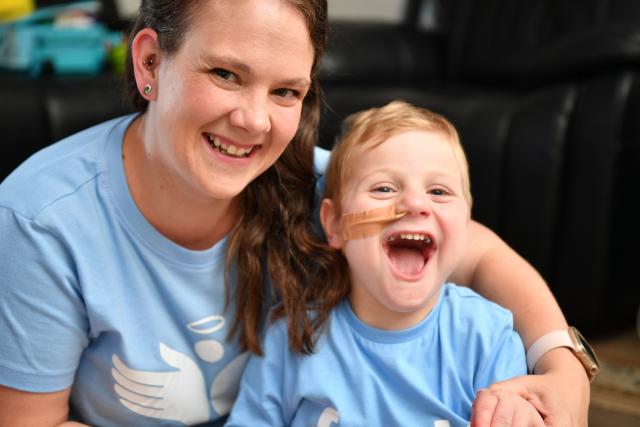
A new screening test for three rare genetic disorders in babies is giving hope to parents like Wollert’s Chrissy Cimino, as Elsie Lange finds out.
Wollert mum Chrissy Cimino might have avoided many months of waiting and worry had new genetic screening technology been available for her son, Elliott, five years ago.
Elliott has Angelman’s syndrome – a rare genetic disorder affecting about one in 15,000 live births – but Ms Cimino didn’t find this out until he was 14-months-old.
As an infant, Elliot struggled to put on weight.
At six months, he couldn’t sit or hold his head up properly.
At 10 months, they saw a paediatrician, who said Elliot was just “placid”, and should “catch up”.
“But being a first time mum, you just work things out,” Ms Cimino said.
“You don’t know anything different.”
The new screening technology, developed by Murdoch Children’s Research Institute (MCRI) and funded by the state government, could have identified Elliott’s condition and sidestepped the anxiety Ms Cimino and her husband Ben endured.
The screening by the technology can identify Prader Willi, Angelman and Dup15q – disorders that can lead to varying degrees of intellectual disability, autism, behavioural problems, seizures and severe obesity.
Ms Cimino said getting Elliott diagnosed wasn’t cheap or easy – people with Angelman’s syndrome are renowned for their upbeat personalities and big smiles – sometimes to their detriment.
“Everyone said that I had the dream baby,” she said.
The diagnostic method involves a commonly used ‘heel prick’ test, which allows researchers to look at the number of chemical markers to affected genes.
Ms Cimino is on maternity leave from her job as a nurse and she wishes there was more support for families of people with disabilities.
Her mum has been helping to look after the kids, because she isn’t able to get enough help from the National Disability Insurance Scheme for a support worker.
“That’s not the role of a grandmother,” Ms Cimino said.
Elliott’s been having undiagnosed seizures since he was seven months old and if he had the diagnosis, the “electrical storm” in his brain would have been controlled.
And not only is it underdiagnosed, Angelman’s syndrome is also misdiagnosed – sometimes as autism, because they are non-verbal, or as cerebral palsy.
When Elliott was diagnosed, Ms Cimino was pregnant with her second child.
“From the newborn screening, what can happen is that we could have gone and done the newborn screening and know that our other two daughters are fine,” Ms Cimino said.
Had they found out earlier, she would have been able to access the equipment necessary to make Elliott’s life easier, but because they only found out when he was 14 months old, she felt like they were on the backfoot.
Before the new screening was the developed, Ms Cimino said the only other way she could have found out about her other babies were more “invasive” forms of of testing, and she said the new testing means she would not have to “run the risk of miscarriage”.
“There’s a whole anxiety around that procedure,” she said.
She describes her four-year-old boy as affectionate, loving and full of laughter – but this is not always easy for his parents when he’s unwell.
“You can have the biggest genuine hug, it’s an open-mouth-style kiss. It’s very unique,” Ms Cimino said.
“Full of absolute love and joy.”
“But it can be really hard as well, because we can present and he can be really sick but he’s still happy.”
The mother of three said she’s grateful for the support networks supporting Angelman families, because without them, she wouldn’t have known Elliott had the disorder for a long time to come.
It was when Ms Cimino stumbled across an organisation online, Foundation of Angelman Syndrome Therapeutics (FAST), and watched a video called ‘What does Angelman look like’, that she and her husband saw their son represented for the first time.
“I said to my husband ‘Oh my god, Elliot has Angelman syndrome,”
She said it was a relief and after further research, the family came across Angelman Syndrome Association of Australia (ASAA), connecting Ciminos to other families and providing support.
For Ms Cimino and the Angelmans syndrome community, it’s exciting to see further research and therapeutics to do with the disorder coming to Australia.
“That’s super exciting, and to improve their quality of life, and that’s all funded by the Angelman community,” she said.
“The future is bright for them.”
She says that if parents think their child might have Angelmans, to go into the process with an open mind, and that the community will support them.
“If you think your child’s got Angelmans syndrome, go to the FAST website, go and see the ASAA, because we’re the ones that live this everyday,” Ms Cimino said.
“And we will guide you through it, and it will be okay.”






